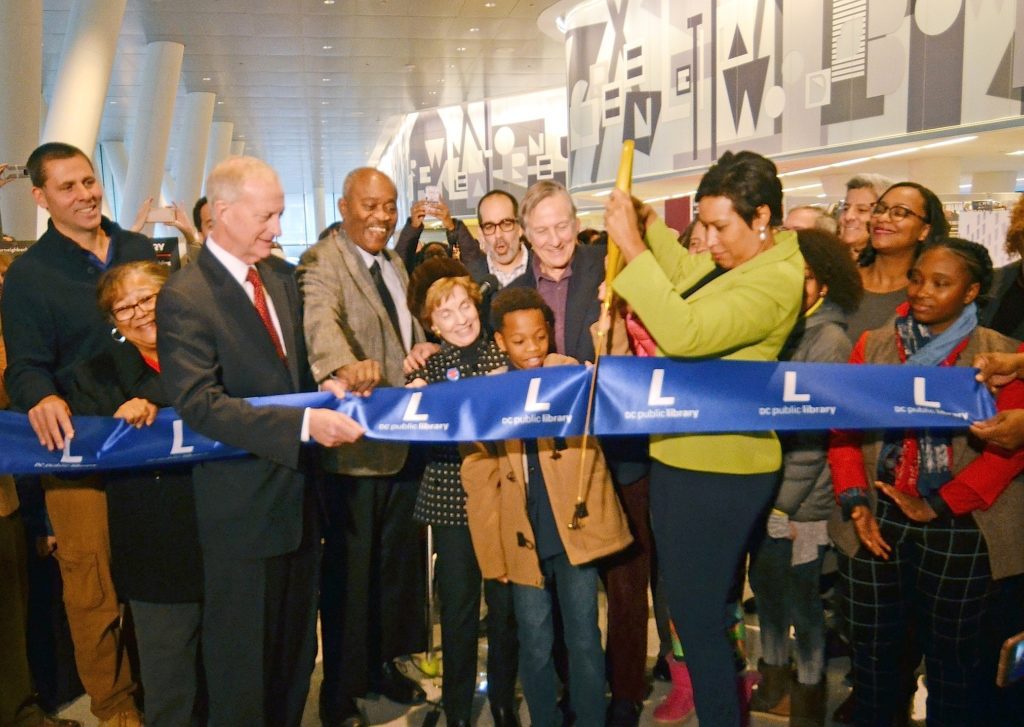Glass-Encased West End Library Opens
By • December 11, 2017 0 1611

A light snowfall — the first of the winter — didn’t dampen the enthusiastic presence of hundreds of West End residents and D.C. dignitaries on Saturday, Dec. 9, when Mayor Muriel Bowser and District of Columbia Public Library Executive Director Richard Reyes-Gavilan cut the symbolic ribbon to open the District’s latest and most contemporary public library, the West End Library at 2301 L St. NW.
Designed by D.C.-based CORE Architecture + Design, the library is encased in a two-story-high, ceramic-fritted glass façade along L Street as part of the Westlight building, which was designed by TEN Arquitectos. The massive open space inside is slashed by white structural concrete columns, marking the various reading rooms, the teen area and the children’s section. A Bluestone Lane café will open next month near the entrance; readers will be allowed to bring closed beverage containers into the library itself.
The 21,000-square-foot library contains seating areas for some 200 people. There are 40 public-access computers with free WiFi, a large programming room for up to 100 people, a conference room for up to 14 people and five quiet study rooms. The book stacks inside are in vivid multi-colored hues. The mural by Adrienne Gaither that runs along the entire back wall is a natural-toned abstract collage of letters spelling out the names of people who are part in the neighborhood’s history, such as Duke Ellington, Petey Green and Colbert King.
The West End Public Library is the first library in D.C. to be entirely planned, funded and constructed as a public-private partnership, according to Deputy Mayor for Planning and Economic Development Brian Kenner. The public entity is the District government, which oversaw the library and the adjacent West End Fire Station. The private part is the EastBanc development company, which built the library along with the luxury and affordable housing condominium complex, still under construction, known as Westlight.
“I grew up in a house that sat just about here,” said Washington Post columnist Colby King, pointing more or less to the back of the main reading room. “It’s a sacred spot, where also our first TV stood. I got my first library card at the main library on K Street in 1949. Since then, I have had many passports and passes, but the most important was this one,” he said, holding up his library card. King’s name is easily deciphered on the wall mural.
“I see this as an international center as well,” said developer Anthony Lanier, who founded EastBanc in 1987. “With the World Bank and International Monetary Fund headquarters just blocks away, I see the library and especially the café as a place where international people meet to read magazines in different languages and to discuss policies over a good cup of coffee,” he said. “Where else is there around here now to get international publications?”
“Libraries today go way beyond the book, however,” said Council member Jack Evans. This library will be a kind of community center, he pointed out, offering dozens of courses, computers and educational resources, plus help in finding jobs.
There will also be an effort to minimize undue use of the facility by the city’s growing homeless population, Evans said. “We’re working on screening and other processes.”
A stand familiar to airline passengers stood next to the door, with a frame into which a small roll-on bag would fit. “One bag allowed per customer — this size or smaller,” read the sign above it. Two other instructions read: “one personal bag allowed per customer (purse, backpack or laptop bag)” and “any activity that interferes with customer or staff use of the library is prohibited.” There were also a couple of (apparently friendly) security guards.
The only thing the library seemed to lack on ribbon-cutting day was a coat room. Wet jackets, umbrellas and hats were draped over all the tables.
“Always looking for good ideas to improve things,” acknowledged Reyes-Gavilan.
It was obvious that this was not your old library. There are no signs to maintain a hospital-like quiet anywhere. And as for keeping books away from coffee and food, that’s history, too. Quoting a former library, Georgetown Business Improvement District CEO Joe Sternlieb said: “We allow books to be lent out that go home and are set next to food and coffee in our readers’ kitchens, so why not here?”

